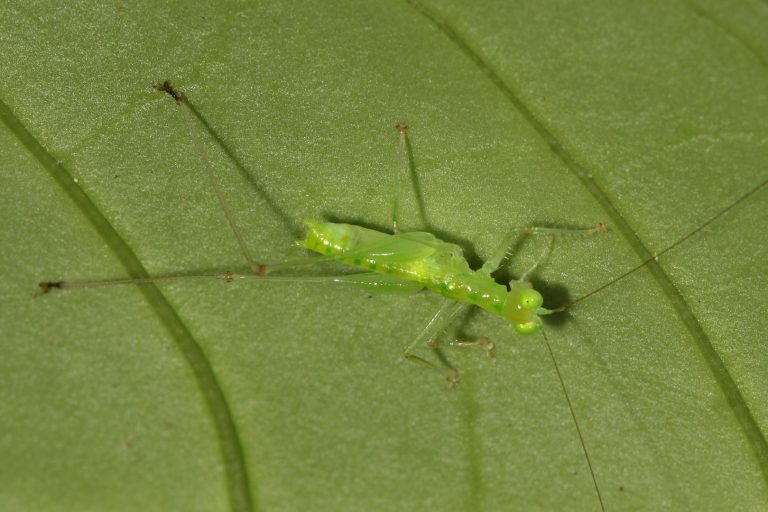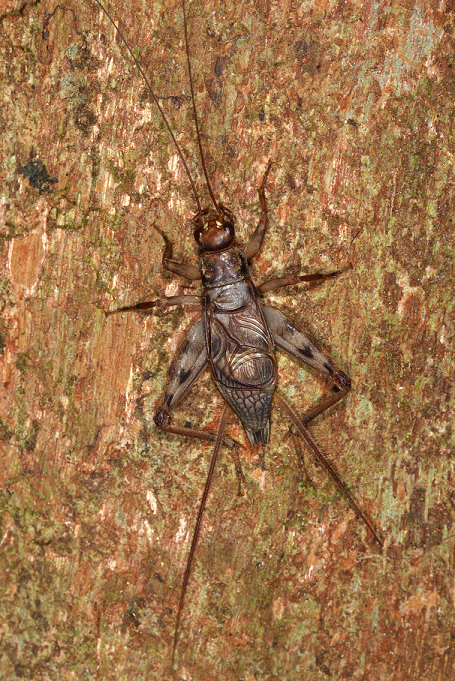To study the orthopterans from Brunei Darussalam and advancing knowledge on the understudied orthopteran diversity in Borneo and Southeast Asia, Dr Tan Ming Kai from the National University of Singapore first set foot in Brunei Darussalam between 2016 and 2017. He headed to the renowned Kuala Belalong Field Studies Centre at the Temburong District. Kuala Belalong proves to be a sanctuary for orthopterans. There, a species of grasshopper (Craneopsis olivacea), bearing a huge spine on each of its foreleg mimicks the thorns of its host plant, Citrus limon. Species can range from a raspy cricket, Phlebogryllacris venosa, which has an entirely blood red body, to a katydid (Phyllomimus sp.), that masters the mimicry of a lichen and leaf. During this first concerted study of orthopterans, Ming Kai discovered as many as 11 species of orthopterans new to science, including a new genus of katydid, among as many as 72 species from Kuala Belalong.
Yet, this represents merely a small proportion of the estimated orthopteran species diversity in the entire Brunei Darussalam, with a wide variety of forest types (i.e., peat swamp, mangrove, heath and montane forests) not yet sampled. As such, Ming Kai expanded his exploration of Bruneian orthopterans into the Belait District since the start of 2019, while continuing his sampling effort at Kuala Belalong to learn more about the species beyond their names and original descriptions. Within a year, Ming Kai, together with Rodzay Haji Abdul Wahab from the Institute for Biodiversity and Environmental Research (IBER), has published on the discovery of another three species of crickets new to science, two of which were named after Brunei and Belait respectively: Pteroplistes bruneiensis Tan, Gorochov & Wahab, 2019 and Tembelingiola belaitensis Tan, Gorochov & Wahab, 2019. Nonetheless, this is still a work in progress as more specimens collected in Belait were being identified. And there is already at least one new genus of eneopterine crickets found in Belait. Surprisingly, this cricket can also be found in Sarawak near the Belait District yet has not been collected from Temburong. A manuscript detailing the new species discovery and its calling songs is currently under preparation.
Orthopterans are renowned for their ability to produce and hear sound. Indeed, Ming Kai is also looking into the bioacoustics of orthopterans in additions to the new species discovery and taxonomic research. Specifically, he is documenting the songs of crickets and katydids that sing at ultrasonic frequencies. Many of these songs has frequencies of beyond 40 kHz. The aim of discovering these previously-unknown ultrasonic singing katydids is that while nearly 70% of katydids examined communicate using ultrasonic calls, most of these species do not occur in the hyper-diverse and highly threatened tropical forests in Southeast Asia. This is despite Southeast Asia being “the noisiest places on earth to the human ear (and orthopterologically speaking)”. The dearth of knowledge and the neglect on the bioacoustics of Southeast Asian ultrasonic singing katydids are problems that need to be resolved to advance conservation in Southeast Asia and basic sciences, especially since these katydids are important prey to charismatic bats and important players in acoustic ecology.

A first-of-its-kind, region-wide paper was published in Bioacoustics on ultrasonic singing Asiophlugis katydids, also known as crystal katydid owing to its translucent body. Using hand-held ultrasound-sensitive bat detector, Ming Kai recorded songs of six species from Malay Peninsula and Borneo, including Asiophlugis longiuncus from Belait. This was usually done after dusk, during which these katydids are most active. These songs were the first to be recorded for each of the species. Although the songs are similar in that they are all ultrasonic and are made up of a series of “zips”, they are also distinctly different among the different species based on acoustic parameters such as pulse duration and peak frequency. Additionally, Ming Kai also demonstrated that stridulum anatomy (i.e., structures on the wings that helped with producing sound) is distinct between species but less so between subspecies of Asiophlugis. This study showed that ultrasonic songs and stridulum anatomy can be useful information to delineate morphologically cryptic katydid species, even if it is rarely used for many Southeast Asian taxa.
Nonetheless, bioacoustics research on ultrasonic species in this region is still in its infancy. To address the gaps in the ultrasonic singing katydids from Southeast Asia, Ming Kai continues to record the songs of other katydids, such as species from Conocephalinae, Meconematinae and Lipotactinae. In the coming years, Ming Kai hopes to record the songs of the many new species of Meconematinae he and his collaborators described from Kuala Belalong, including Pseudoteratura (Pseudoteratura) kenuan Tan, Gorochov & Wahab, 2017 and Alloteratura (Alloteratura) belalongensis Tan, Gorochov & Wahab, 2017.
Text & photos by: Dr Tan Ming Kai, National University of Singapore




